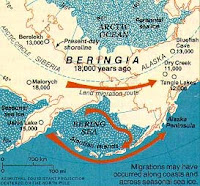Immigration is woven into the DNA of mankind. According
to National Geographic, there is a theory that over 25,000 years ago, when the
7 continents are believed to still have been connected, thousands of people
emigrated on foot from what is now known as Siberia to Alaska.
This alone proves immigration is nothing new. When
we are not satisfied with something, we have the motivation to walk away and
find what we need somewhere else.
With all the current public discussion of
immigration law reform in the U.S. and the ballooning backlog of immigration
applications here in Canada, I was inspired to take a look into the history of
immigration to North America. I trust you will find these glimpses as
interesting as I have.
Every Canadian and U.S. citizen has immigrant roots
in their personal history.
But back to our Siberian nomads. Once arriving in
the Alaska area, also known as the Bering Land Bridge between Asia and the
Americas, the people were met with two massive glaciers insurmountably blocking
their path forward. With no way to move on, the population decided to create
their society there on the land bridge and essentially wait it out.
They would colonize, cultivate and survive in
sharp, frigid, Siberia-like conditions for the next 10,000 – 20,000 years.
That’s not a typo: a 20,000 year rest stop. Eventually the Earth’s environment
began to shift, and a path beyond the glaciers presented itself. This enabled
the population to immigrate into what would become Canada and the United
States, as well as parts of Mexico and South America. They would become the
indigenous people of these continents.

Around the year 1000 AD, it is believed that
Norwegian explorer Leif Ericson would land on the coast of what is now
Newfoundland and Labrador, leading the first-known European expedition to step
foot on North America. While there are two tales behind if he landed there on
purpose or by mistake, he and his crew would nevertheless settle there to
explore what they would name “Vineland” – named for the discovery of ample
amounts of grape vines.
 Most of us know the saying “in 1492 Columbus sailed
the ocean blue”. Italian explorer Christopher Columbus would set out to find
India on the dime of the Spanish Queen. He would miss his mark and land on an
island in the Bahamas, and then continue on to Florida.
Most of us know the saying “in 1492 Columbus sailed
the ocean blue”. Italian explorer Christopher Columbus would set out to find
India on the dime of the Spanish Queen. He would miss his mark and land on an
island in the Bahamas, and then continue on to Florida.
Columbus is regarded by many as the man who
discovered the “New World”. Protests by Native American historians and
activists still occur to this day regarding Columbus’ claims of discovering a
place that was already inhabited and the alleged crimes of humanity he
committed against its inhabitants.
Regardless of how you feel about either Ericson or
Columbus, it would be these two men and their crews that would pave the way for
a future of other Europeans to immigrate to North America.
We must also lend the proper recognition to the
history of slavery, and the understanding that not everyone chose to immigrate
to North America. African people were
being forced into slavery and transported to our continent as early as
1619.
 The first Chinese immigrants to North America
landed in Nootka Sound on Vancouver Island in 1788 with British explorer John
Meares. 70 Chinese carpenters built him a boat and then, it is thought, they
married into the native communities of Vancouver Island, and their cultural
traces were quickly assimilated. For centuries before this, it was forbidden to
emigrate from China and it was considered a capital crime.
The first Chinese immigrants to North America
landed in Nootka Sound on Vancouver Island in 1788 with British explorer John
Meares. 70 Chinese carpenters built him a boat and then, it is thought, they
married into the native communities of Vancouver Island, and their cultural
traces were quickly assimilated. For centuries before this, it was forbidden to
emigrate from China and it was considered a capital crime. 
The pioneer Japanese immigrants known as the
“Issei” first arrived in Hawaii in 1868 and then in Canada between 1877 and
1928. 10,000 Japanese immigrants were settled permanently in Canada by the year
1914.
Canada is most certainly known and praised for
its multicultural and multinational historic diversity. The
latest Statistics Canada census recorded just over 6 million foreign-born
people in Canada.
This represented virtually one in five or 20% of the
total population. This is the highest proportion in 75 years. In
1901, there were 25 reported ethnic origins represented in the Canadian
population. The most recent Statistics Canada census results accounted for over
200.
We must welcome with care the people that opt to
leave their countries behind so they can share their lives with us here in
North America. Our everyday actions should never agitate the oftentimes already
turbulent process immigrants’ face. Why disrespect anyone that sets out to
instil a sense of courage, adventure and security into their own family legacy?
Patience, mindfulness, empathy and respect are key to
smoothly integrating the emigrated into our teams and communities.



No comments:
Post a Comment